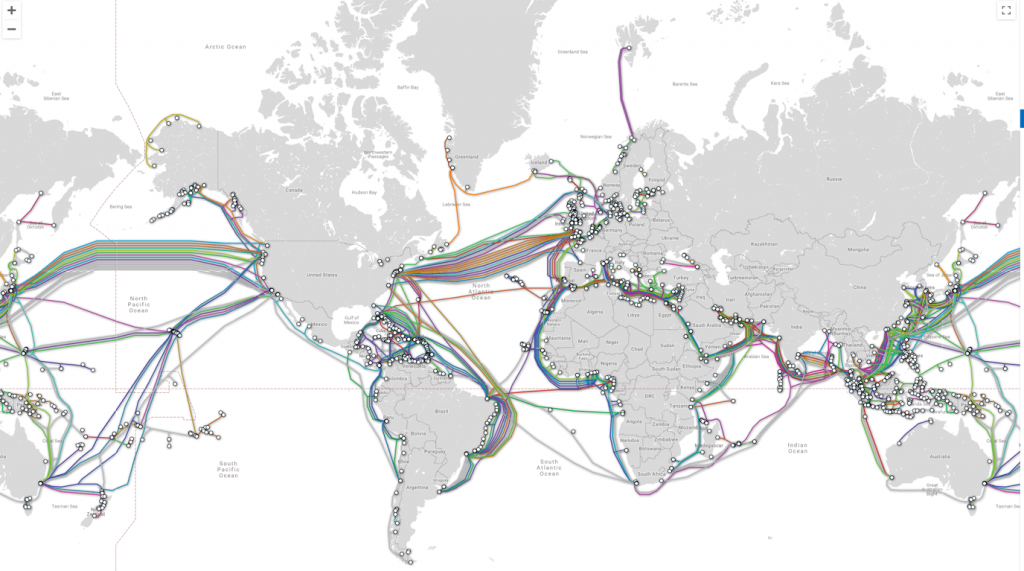
Nearly all international data is carried by a mesh of submarine cables connecting virtually every region in the world. While the initial deployments of the submarine network date back to the mid-19th century, the recent explosion of Internet traffic has driven an exponential proliferation of the total capacity required from this infrastructure. Today, the submarine cable network is recognized as vitally important to the global economy and as an enabler of sustainable growth in developing regions.

The majority of these cables have been constructed and managed by consortia, and are shared by multiple network operators, although the latest construction boom has been largely driven by content providers such as Google, Facebook, Microsoft, and Amazon. According to TeleGeography, the amount of capacity deployed by content providers has risen tenfold between 2013 and 2017, outpacing all other customers of international bandwidth.
Despite the obvious importance of the submarine cable network (SCN), we lack a clear understanding of its criticality in the global Internet. While it is generally understood that Internet services rely on the SCN for backend traffic, the common assumption is that most Internet users do not directly depend on it, as popular resources are either locally hosted, or cached, by nearby CDN servers and data centers. However, the recurrence of country-wide disconnections or performance issues as a result of submarine cable cuts casts doubt on this assumption.
How do we define a user-view of criticality?
Our team at Northwestern University, in collaboration with IIJ Research Lab, have been studying the criticality of the SCN from the perspective of end-users.
The main goal of our initial study was to capture the reliance on the SCN while users browse websites from different areas around the world. To capture this aspect, we defined the criticality of the SCN for any given region as the fraction of resources loaded via submarine cables while browsing the most popular websites of that region. Our methodology consists of several steps including identifying web resources, geolocating servers and tagging submarine cable routes.
Read: At the bottom of the sea: a short history of submarine cables
We recently presented the first version of this general methodology at ACM Internet Measurement Conference (IMC) 2020, together with results from applying it to 63 economies from every inhabited continent. We have carefully selected our vantage points so that, collectively, our dataset captures ≈80% of the global Internet population.
End-user reliance on the SCN
Not all economies rely on the SCN to the same extent; one could expect that the SCN will be more critical to an island economy, for instance, than to one without access to water. We categorize all economies in our study as Island, Landlocked or Other (Coastal Continental) economies, based on their accessibility to water and thus submarine cables.
Our preliminary findings show that for island economies, 64.33% of all resources are accessed via the SCN compared to 43.18% for non-island economies. Stated differently, as much as 64.33% of resources requested while web browsing can be affected by a submarine cable outage. More surprisingly, even landlocked economies — those without direct access to an ocean — depend significantly on the SCN, with an average 16.25% of all web requests accessed through a submarine cable.

Figure 2 shows the distribution of the SCN ‘hit’ rate when browsing the most popular websites for each of the three geographical categories. Each box plot presents a minimum, medium, and maximum value, as well as the first and third quartile.
We also perform additional analysis on the SCN criticality for CDN hosted resources. We find that, despite the explosive growth of datacentre and CDN infrastructure around the world, at least 28.22% (and as much as 65.1%) of the CDN-hosted resources are accessed over a submarine cable.
The ability to retrieve a website’s landing or index page — the first resource to be requested when visiting a web site — is critical when browsing the web. We found, surprisingly, that an average 22.85% of websites for all economies in our dataset hit a SCN path during retrieval, further highlighting the criticality of the SCN to users’ quality of experience.
To encourage further research in the space, we’ve made our measurement framework, dataset, and analysis code publicly available via GitHub. We welcome any questions in the comment section below.
Shucheng “Alex” Liu is a PhD student in Prof. Fabián E. Bustamante’s research group at Northwestern University.
Prof. Bustamante contributed to this post .
This work was done in collaboration with the IIJ Research Group.
The views expressed by the authors of this blog are their own and do not necessarily reflect the views of APNIC. Please note a Code of Conduct applies to this blog.

Thanks for highlighting this very important aspect of the global Internet. i read your paper as referenced in the article. In the Asian economies covered by your study, is India Included and if yes can the data point be shared.